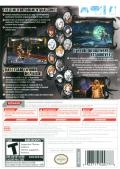Existing User Log In
New User Registration
Register for a free account to gain full access to the VGChartz Network and join our thriving community.





America - Front


America - Back

17th Jul 2009 | 1,796 views
Castlevania: Judgment was easily one of the most controversial games released in 2008, and is still the source of much heated debate even today. But is this Gaiden a diamond in the rough, or is it truly the abomination some have claimed?
Castlevania Judgment is split into six game play modes: Story, arcade, castle, versus, survival and Nintendo wi-fi connection. Story will be the mode most players will flock to and with good reason. The gist of the story is that some unseen force has torn a rift through time, placing the Castlevania world in grave danger and mutilating the timeline into a strange cross-roads of sorts. At the center of this cross-road waits an entity known only as Aeon, who seeks aid in mending the rift, and confronts each cast member to measure their potential.
Though the roster is relatively small and there have been some truly head-scratching choices regarding which characters are available, long time fans of the series need not worry as each selectable character’s personality has been translated into the game smoothly. Each fighter‘s style is unique (even Simon and Trevor Belmont have some distinction between them), allowing avid fans a fresh experience each time they choose a different character, while the fighting itself is like a mixture of Smash bothers and Power stone, with characters fighting on an intractable 3-D landscape with all moves being executed in the same manner for all characters though with vastly different moves, meaning that timing rather than button skill takes priority. Arcade is a simple vs. CPU exercise in which whomever the player has selected wages a one-man-war against 8 opponents, with their completion time being recorded after each session, similar in execution to survival mode. Versus is just a simple two-player match, and practice mode is a self-explanatory exercise to test out combos and strategies, with nearly all AI setting being adjustable.
Sadly, one of these modes is a true failure; Castle mode. The idea behind Castle mode is that your selected character must fight his or her way through thirty rooms throughout castlevania either by fulfilling a certain requirement or just beating some ass, culminating in a fight with a over-buffed Dracula. The problem is the game’s sloppy manner in presenting this scenario, either presenting the player with cookie-cutter match-ups that do nothing to stimulate or entertain, or completely crippling them with severe handicaps in one-sided death-matches. Even the tasks themselves are unforgiving, such as demanding that six items be gained in the torture-chamber stage against an immortal Maria Renard. (even if you’re playing as Golem!) If you somehow manage to claw your way through this hell, your rewards are barley sufficient; just the character’s voice data, theme, and artwork. It’s clear that the developers just didn’t have enough time to work on this setting, it’s a real shame seeing as it had some potential behind the cruelty.
Another touchy aspect of the game is it’s balance. While the average player should have no difficulty making the most with all characters, at higher levels of competition three individual’s stand out as being truly broken, while one hides it’s face in shame as the worst character in the game. Shanoa, Maria Renard, and Dracula are completely over-powered and will have no trouble devastating the other characters with little effort, especially in Shanoa’s case. Lurking at the opposite end of the spectrum is Golem, whose slothful movements, excessive lag and obvious tells keep the poor abomination at the bottom of anyone’s tier list, and rightfully so. Thankfully, though, the other characters all have enough individual cons to help level the playing field, such as Eric’s ample lag to make up for his brutal strength.
What worried most players about Judgment the most ironically turned out to be the area of least concern in the finished product; the controls.; First and fore-most the Wii-remote set up is manageable, but can get repetitive over time even though it does succeed in mimicking a whip’s actual motions. Gamecube and classic controller’s work just fine, and the unique button lay-out prevents people from mixing up their moves. Even the aesthetics presented by the superb graphics shine through on their own, such as the bubbling poison in the Torture chamber or the fog rolling across the ground in the Destroyed monastery, even though certain backdrops such as the time-rift’s vortex present only around 80% of this level of polish, and the character models possess a strange “shine” to them; it isn’t so much a hindrance as just plain odd, perhaps the dev. Team was worried that players would lose themselves in the games dark backgrounds and tried to fix it at the last minute? The music is easily one of the high-lights from the game, with excellent remixes provided by music director Hideki Sakamoto.
Though Castlevania: Judgment has it’s share of problems, it is by no means a terrible game and is far from the worst fighting game released this console generation, and is a definite must for fans, if only to settle the Simon vs. Alucard arguments
| Total Sales |
0.01m
Japan |
0.12m
NA |
0.02m
Europe |
0.01m
Others |
0.16m
Total |
| 1 | n/a | 13,160 | n/a | 2,322 | 15,482 |
| 2 | n/a | 6,510 | n/a | 1,149 | 7,659 |
| 3 | n/a | 3,772 | n/a | 666 | 4,438 |
| 4 | n/a | 3,566 | n/a | 629 | 4,195 |
| 5 | n/a | 6,550 | n/a | 1,156 | 7,706 |
| 6 | n/a | 5,573 | n/a | 983 | 6,556 |
| 7 | n/a | 2,426 | n/a | 428 | 2,854 |
| 8 | n/a | 1,778 | n/a | 314 | 2,092 |
| 9 | 3,697 | 1,503 | n/a | 320 | 5,520 |
| 10 | 1,265 | 1,284 | n/a | 255 | 2,804 |
|
|
|
|
|
|
|
|
|
|
|
|
|
|
|
|
|
|